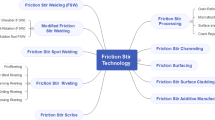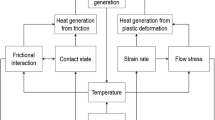Abstract
Friction stir welding (FSW) has been successfully applied in fabricating many critical structures, e.g. rocket fuel tanks. Generally, CFD simulation is required to better understand the in-process material flow during FSW. In this paper, we discuss the concepts and the approaches that have been employed in the recent development and application of the CFD simulation for FSW. First, special considerations on friction, heat generation and transient tool motion have been adopted to capture the fully-coupled heat-and-mass-flow phenomenon during FSW. Second, temporal evolution of the material state during welding is analyzed by interpolation and integration along the flow paths, which is further used to predict the typical feature and defects in the welds. Third, the CFD-based predictions on the temperature and the material flow are validated by experimental measurements. Finally, the current concepts and approaches in the simulation of FSW could be applied in CFD-based studies on other similar thermal-mechanical processes.
Access this chapter
Tax calculation will be finalised at checkout
Purchases are for personal use only
Similar content being viewed by others
References
Mishra RS, Ma ZY (2005) Friction stir welding and processing. Mater Sci Eng R 50 (1–2):1–78
Shi L, Wu CS, Liu HJ (2015) The effect of the welding parameters and tool size on the thermal process and tool torque in reverse dual-rotation friction stir welding. Int J Mach Tool Manuf 91:1–11
Fratini L, Buffa G (2005) CDRX modelling in friction stir welding of aluminium alloys. Int J Mach Tool Manuf 45(10):1188–1194
Chen GQ, Shi QY, Li YJ, Sun YJ, Dai QL, Jia JY, Zhu YC, Wu JJ (2013) Computational fluid dynamics studies on heat generation during friction stir welding of aluminum alloy. Comput Mater Sci 79:540–546
Su H, Wu CS, Pittner A, Rethmeier M (2014) Thermal energy generation and distribution in friction stir welding of aluminum alloys. Energy 77:720–731
Colegrove PA, Shercliff HR (2003) Experimental and numerical analysis of aluminium alloy 7075-T7351 friction stir welds. Sci Technol Weld Joining 8(5):360–368
Colegrove PA, Shercliff HR (2005) 3-dimensional CFD modelling of flow round a threaded friction stir welding tool profile. J Mater Proc Technol 169(2):320–327
Nandan R, Roy GG, Lienert TJ, Debroy T (2007) Three-dimensional heat and material flow during friction stir welding of mild steel. Acta Mater 55(3):883–895
Yu Z, Zhang W, Choo H, Feng Z (2012) Transient heat and material flow modeling of friction stir processing of magnesium alloy using threaded tool. Metal Mater Trans A 43(2):724–737
Liu X, Chen G, Ni J, Feng Z (2016) Computational fluid dynamics modeling on steady-state friction stir welding of aluminum alloy 6061 to TRIP steel. J Manuf Sci Eng 139(5):051004
Kumar K, Kalyan C, Kailas SV, Srivatsan TS (2009) An investigation of friction during friction stir welding of metallic materials. Mater Manuf Process 24(4):438–445
Davim JP (ed) (2012) Tribology in manufacturing technology. Springer, Berlin
Su H, Wu CS, Bachmann M, Rethmeier M (2015) Numerical modeling for the effect of pin profiles on thermal and material flow characteristics in friction stir welding. Mater Des 77:114–125
Chen G, Feng Z, Zhu Y, Shi Q (2016) An alternative frictional boundary condition for computational fluid dynamics simulation of friction stir welding. J Mater Eng Perform 25(9):4016–4023
Zhu Y, Chen G, Chen Q, Zhang G, Shi Q (2016) Simulation of material plastic flow driven by non-uniform friction force during friction stir welding and related defect prediction. Mater Des 108:400–410
Colegrove PA, Shercliff HR (2004) Development of Trivex friction stir welding tool Part 2—three-dimensional flow modelling. Sci Technol Weld Joining 9(4):352–361
Nandan R, Roy GG, Lienert TJ, Debroy T (2006) Numerical modelling of 3D plastic flow and heat transfer during friction stir welding of stainless steel. Sci Technol Weld Joining 11(5):526–537
Ji S, Shi Q, Zhang L, Zou A, Gao S, Zan L (2012) Numerical simulation of material flow behavior of friction stir welding influenced by rotational tool geometry. Comput Mater Sci 63:218–226
Arora A, Nandan R, Reynolds AP, Debroy T (2009) Torque, power requirement and stir zone geometry in friction stir welding through modeling and experiments. Script Mater 60(1):13–16
Atharifar H, Lin D, Kovacevic R (2009) Numerical and experimental investigations on the loads carried by the tool during friction stir welding. J Mater Eng Perform 18(4):339–350
Pan WX, Li DS, Tartakovsky AM, Ahzi S, Khraisheh M, Khaleel M (2013) A new smoothed particle hydrodynamics non-Newtonian model for friction stir welding: process modeling and simulation of microstructure evolution in a magnesium alloy. Int J Plast 48:189–204
Chen G, Feng Z, Chen J, Liu L, Li H, Liu Q, Zhang S, Cao X, Zhang G, Shi Q (2017) Analytical approach for describing the collapse of surface asperities under compressive stress during rapid solid state bonding, Script Mater 128:41–44
Morisada Y, Imaizumi T, Fujii H (2015) Determination of strain rate in Friction stir welding by three-dimensional visualization of material flow using X-ray radiography. Script Mater 106:57–60
Seidel T, Reynolds AP (2001) Visualization of the material flow in AA2195 friction-stir welds using a marker insert technique. Metal Mater Trans A 32(11):2879–2884
Acknowledgements
The research was supported by the National Natural Science Foundation of China (Grant No. 51375259 and Grant No. 51705280) and the National Science and Technology Major Project of the Ministry of Science and Technology of China (No. 2012ZX04012-011).
Author information
Authors and Affiliations
Corresponding author
Editor information
Editors and Affiliations
Rights and permissions
Copyright information
© 2018 The Minerals, Metals & Materials Society
About this paper
Cite this paper
Chen, G., Shi, Q., Zhang, S. (2018). Recent Development and Applications of CFD Simulation for Friction Stir Welding. In: Nastac, L., Pericleous, K., Sabau, A., Zhang, L., Thomas, B. (eds) CFD Modeling and Simulation in Materials Processing 2018. TMS 2018. The Minerals, Metals & Materials Series. Springer, Cham. https://doi.org/10.1007/978-3-319-72059-3_11
Download citation
DOI: https://doi.org/10.1007/978-3-319-72059-3_11
Published:
Publisher Name: Springer, Cham
Print ISBN: 978-3-319-72058-6
Online ISBN: 978-3-319-72059-3
eBook Packages: Chemistry and Materials ScienceChemistry and Material Science (R0)




